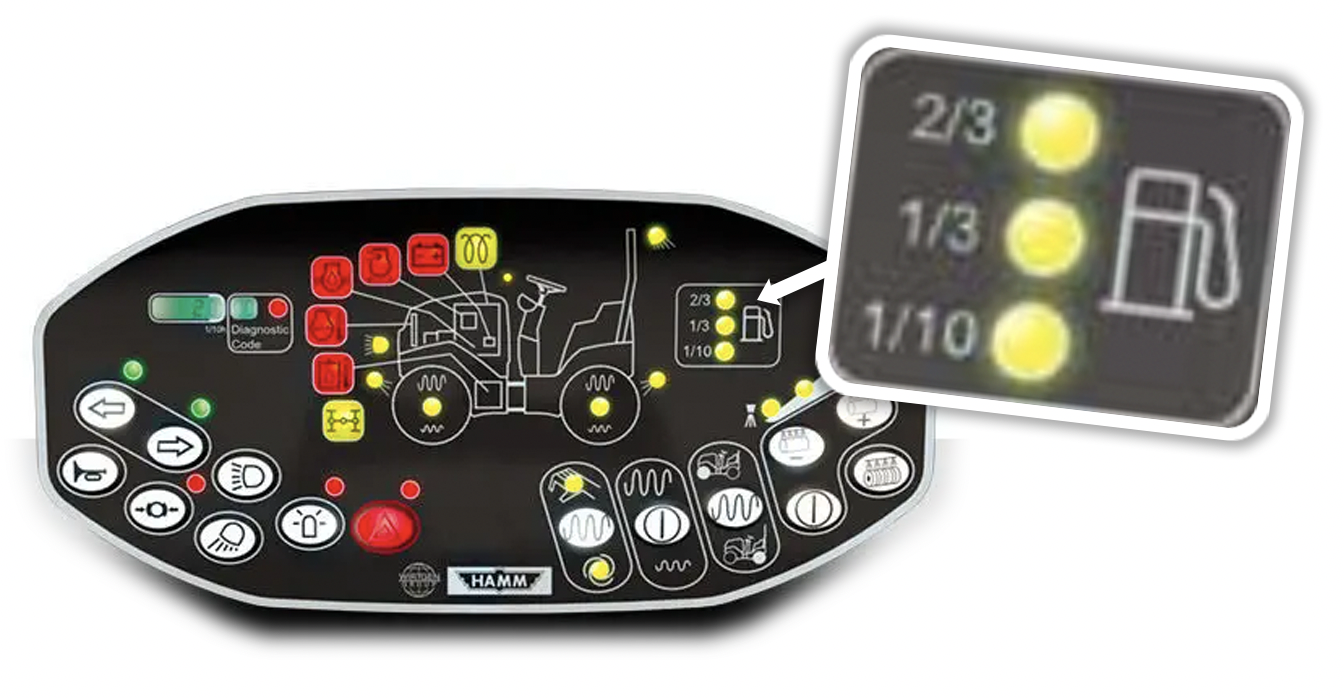Confusingly, this post suggests that the fuel gauge “does a pretty bad job at telling how much fuel there is,” when in fact it does a spectacular job, and it’s our failings as humans that prevent us from knowing what the hell it’s trying to tell us:
Wow, right? It’s incredible. Maybe even sublime. As some of the commenters have pointed out, while the little illustration on the dash seems like it could be a riding lawnmower, it’s not. No, this is something much more exciting: a road-roller.
Specifically, this seems to be a Hamm HD Compactline series of road roller, and we can get a good look at the fuel gauge in context of the whole dash in this well-illustrated brochure: Lovely, isn’t it? Interestingly, the company appears to be using the word “intuitive” in a context I’ve never been exposed to before. This fuel gauge is absolutely fascinating. I’m a firm believer that fuel gauges are ripe places for exploration and improvement – consider the remarkable Nissan 280ZX’s fuel gauge that included a separate sub-gauge just for the last quarter tank. That’s an incredible innovation. Nissan’s extra sub-gauge is a clever expansion of the fundamental fuel gauge concept, but what Hamm is doing is more of a deep re-thinking: Why make a fuel gauge immediately understandable when you can make it complex and obtuse? Let’s look at it again: For a little picture and three labeled LEDs, there’s just so much there. We have three yellowish-green LEDs, labeled 2/3, 1/3, and 1/10. Now, all three are illuminated in this picture, but the real-world picture from the Reddit post just shows the top one illuminated. So, let’s say that’s how it actually works, and this gauge tells you if you have 2/3 of a tank, 1/3, or 1/10. So, it doesn’t ever tell you if you’re actually full or empty, like some conventional boring-ass gauge. This gauge chooses the path of fractions, but, incredibly, somehow doesn’t use a common fucking denominator for all three fractional values chosen. Why is that? Maybe because the company arbitrarily decided to divide the tank into conceptual thirds, then found itself written into a corner when it made its middle level just 1/3, and then had nowhere to go? I mean, Hamm couldn’t even do something that was, you know, a multiple of a third? The 1/10 couldn’t have been, like, 2/9 or something? Then you make 2/3 into 6/8 and 1/3 to 3/9, and at least you’d have a common denominator. I mean, that wouldn’t have been much better, I guess. But why thirds? Why couldn’t this have been, say, 3/4, 2/4, and 1/4? Did the idea of quarters just feel too, I don’t know, wrong? Shit, if we’re going this way, why not F, 1/2, and E, like any sane human being would do? What information are you getting out of this madness-inspiring 2/3-1/3-1/10 trio? The sobering realization that no matter how hard you try, you can never have a completely full tank? Or do they just want people re-doing 5th grade math as they try to find the lowest common denominator between 1/3 and 1/10? What would that be, anyway? 30? So this could maybe have been 20/30, 10/30, and, 3/30? Is that any better? I mean, kinda, because at least we can all accept that somehow this fuel tank is 30 units large? What is the actual size of the tank? Let’s check the Hamm site: So, it’s 8.7 gpm. Wait, gpm? That’s gallons per minute! That’s a rate, not a capacity? Shit, now I’m even more confused. What kind of weird sadists run this Hamm operation, anyway? Even if we assume that’s a typo and it’s an 8.7 gallon tank, that still doesn’t really explain this choice of markings. So, full is 2/3 of 8.7? So, uh, 5.8 gallons? And when you’re at this gauge’s equivalent of empty it’s 0.87 of a gallon? Any Hamm owners/drivers out there want to help me understand this? In the real world, I’d like to bet that people just use this as a full/half/empty kind of thing. Still, hats off to Hamm for not being kowtowed into fuel-gauge homogenity! May all of your gauges read 2/3, forever! 2/3 — don’t worry about it. Plenty of gas. 1/3 — time to fill the tank, no panic. 1/10 — head directly to fill now, panic. It’s FULL when you FILL IT. If you just filled it, you know this, why does the guage need to tell you? You know you have plenty of gas. It’s not a speedo or a tach, it’s not a gauge you stare at while driving (flattening wily coyotes, whatever). It’s a reference to “hey, how we doin over there?”. As a thought experiment I like to reduce instrument design to and beyond functional minimum. Here, one RGB LED could do it: 2/3 green 1/3 yellow 1/10 red DONE 2/3 Get to work 1/3 Call for fuel but keep working 1/10 Get it out of the way but don’t run it dry it’s a diesel Yet any time the tractor was running, the needle of the fuel gauge would vibrate rapidly and violently enough to become a blur between E and F. It didn’t matter how much fuel was in the tractor; if it was running, there was simply no way of knowing. A Hamm’s gauge would have been a great improvement.





